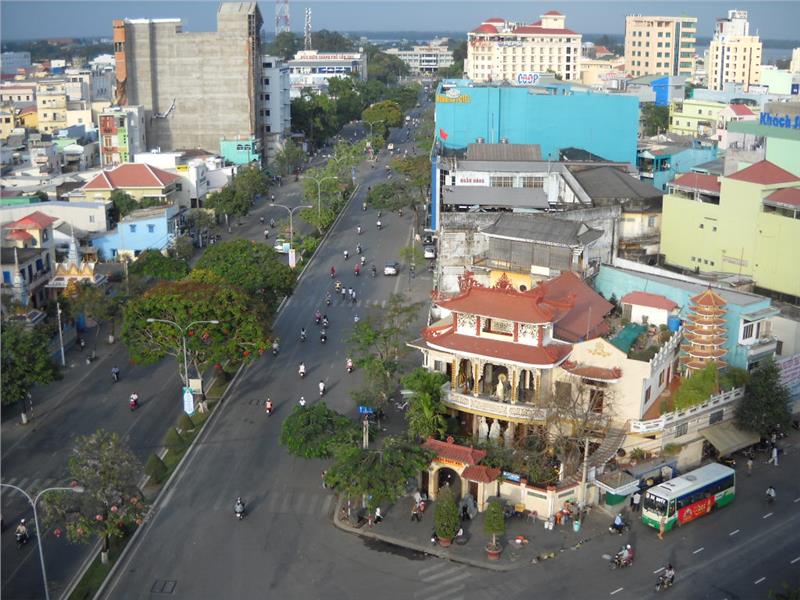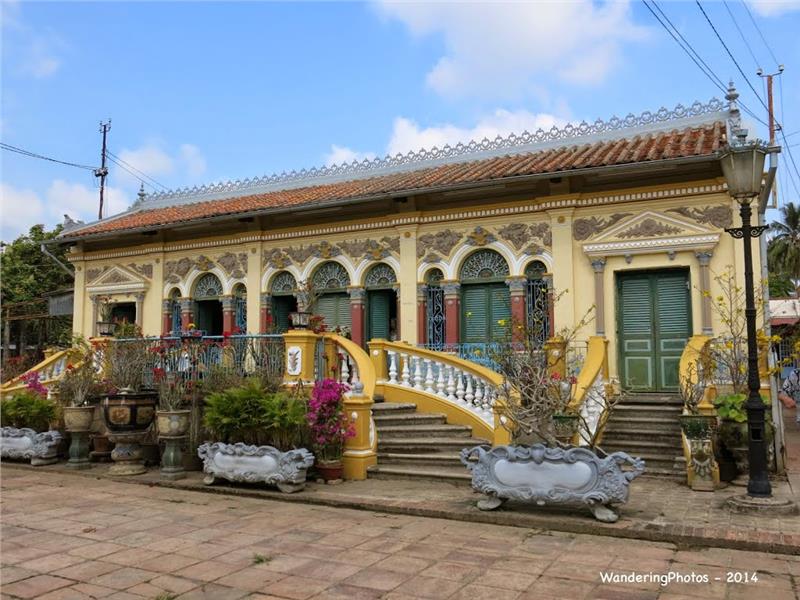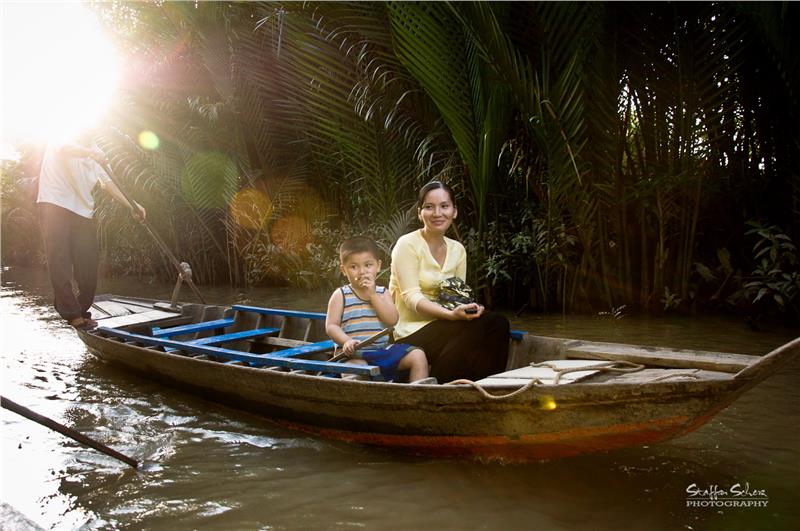Can Tho is a centrally city in Mekong River Delta Vietnam. It is one of five centrally cities in Vietnam. On 24 June 2009, Can Tho city was officially recognized as urban center of grade 1 by Prime Minister, belonging to key economic region in Mekong River Delta and was the forth key economic region in Vietnam.

Geographical location: Can Tho owns a geographic coordinates of 105013’38" – 105050’35" east longitude and 9055’08" – 10019’38" north latitude. The city is adjacent An Giang province to the north, with Dong Thap province to the east, with Kien Giang province to the west, and with Hau Giang province to the south.
Terrain: Terrain generally is relatively flat, which is suitable for agricultural production and fishery. Besides, the city is the home to many dunes and islets in Hau River.
Climate: Can Tho city is situated in Mekong River Delta climate with common characteristics: abundant thermal background; climate indicators (the light, the rainfall, the wind, the evaporation, and the humidity...) differentiate the climate into two contrasting seasons, namely rainy season and dry season.

In 1739, Can Tho was explored and officially presented on Vietnam map with the name of Tran Giang. Along with the ups and downs of Vietnam history, Tran Giang region had undergone many changes in appellation and administrative boundaries. In Nguyen Dynasty, Can Tho was old land of An Giang province. In French colonial period, Can Tho was an independent province and was the center of Northwest region. In the Republic of Vietnam period, Can Tho province was changed into Phong Dinh province. After 1975, the combination of Phong Dinh prvince, Ba Xuyen province and Chuong Thien province established Hau Giang province, in which Can Tho city is provincial town. In late 1991, Hau Giang province was divided into Can Tho province and Soc Trang provine. As a result, Can Tho city is provincial city of Can Tho province. On 26 November 2003, the National Assembly passed Resolution on Can Tho province. Accordingly, Can Tho province became Can Tho city, a centrally city and directly under Hau Giang province.
Can Tho city is sub-divided into 9 administrative units including 5 urban districts of Ninh Kieu, Binh Thuy, Cai Rang, O Mon, Thot Not and four suburban districts of Phong Dien, Co Do, Thoi Lai, Vinh Thanh with 5 towns, 44 wards and 36 communes.
According to census in 2011, the population in Can Tho was about 1,200,300 people with the population density of 852 persons / km². Among them, there are around 791,800 urban population and 408,500 rural population. Natural population growth rate increases by 8.2%.
Can Tho city is home to many ethnic groups. Khmer ethnic people mainly concentrate around temples or intersperse with Vietnamese people in Ninh Kieu district, O Mon district and Thot Not district. Meanwhile, Chinese people usually centralize Ninh Kieu district and Phong Dien district. The Vietnamese is the official language and commonly used here.

In 2012, Can Tho economic growth rate reached 10.3%, the highest level in five centrally cities. Can Tho economy thus gained significant achievements. Industry production value was estimated to increase by 7.5%, total sales of goods and service revenue increased by 18.5%, social development investment capital was 4.97% increase compared to the same period; budget revenue was 5,092 billion VND.
There gradually exists a great number of supermarkets, shopping malls, and big commercial centers in Can Tho: Big C, Metro, Co-op Mart, Maximart, Vinatex, Best Caring, Cho Lon Electrical Accessory Supermarket, Tay Do Commercial Zone, or Cai Khe Commercial Center. Many service sectors in Can Tho has steadily developed as Bank, Health, Education, Culture and Society...
With advantages of developing industry, Can Tho was also driven to develop into an industrial city by 2020.

Education: Up to 30 September 2008, Can Tho city has 255 schools at the universal education level, ranking 11th in Mekong Delta region. In term of university and college, the city is home to many leading universities in Mekong River Delta: Can Tho University, Can Tho University of Medicine and Pharmacy, College of Foreign Economic Relations in Can Tho...
Health: In 2008, Can Tho city retained 83 health care facilities directly under Health Department. Among them, there are 15 hospitals, 8 regional polyclinics, and 60 commune health stations with 1,600 hospital beds. Can Tho is also the convergence of leading hospitals in the region: Can Tho Central General Hospital, Can Tho Children's Hospital, Military Hospital, or Can Tho Hospital of Ear Nose Throat...
Can Tho culture not only maintains features of Mekong Delta region but also displays unique cultural beauty of ancient Tay Do. Tay Do cultural characteristics are reflected in many aspects of culinary, lifestyle, religion, and traditional arts...
In term of communications and mass media, Can Tho also retains broadcasting stations such as Voice of Vietnam, Can Tho Television and Radio Station, Vietnam Television Center in Can Tho city. In addition, the system of cable television is also large with Cable TV, Satellite TV, and radio stations in the districts.

Can Tho city still hides great potential for tourism development, such as Uncle Ho Monument, City Museum, Military Zone 9 Museum, Binh Thuy Temple, Khanh Quang Pagoda, Nam Nha Duong Pagoda, Munir Ansay Temple, Can Tho University, Mekong Delta Rice Research Institute, Hau River Farm...They all have capacity for developing cultural tourism in Can Tho.
The system of interlaced rivers, the great number of traditional villages, and ecological landscape potential as Cai Khe Islet, Khuong Islet, Au Islet, Tan Loc Islet, Thoi Nhat flower village, Ninh Kieu wharf, Cai Rang floating market, and Phong Dien floating market...connected to the city center by road traffic systems and waterways. In addition, Can Tho has invested some other types of tourism services such as amusement parks, or workshop tourism...The city is always available to welcome and and serve tourists with a system of restaurants, hotels, motels mostly classified from the 4-star standard. The system of accommodation services in Can Tho has been gradually standardized.
Festival

Thanks to the coexistence of three ethnic Vietnamese - Khmer - Chinese people, there are many unique festivals in Can Tho. These festivals were created from traditional practices or folk beliefs of each ethnic group.
Ong Pagoda Festival: On annual 7 July (lunar calendar), Yu Lan Festival lasts 2 - 3 days. In the festival, there are many traditional activities of local people, which actually leave deeply impression to both domestic and foreign tourists.
Binh Thuy Temple Festival: Apart from full-moon day ceremonies in lunar months and Tet holiday, two other great festivals attached to the agriculture are annually organized solemnly and regularly in Binh Thuy Temple. Throughout the festival, many cultural activities vibrantly take place: boat racing, unicorn dance, the cocks' combat, the ducks hunting, or the fight with cord...reflecting a crowned and sublime culture.
Cholchonam Thomay Festival: On 13, 14, 15 March (lunar calendar), Khmer people in the South, especially in Tra Vinh province, Soc Trang province, and An Giang province merrily celebrate Cholchonam Thomay Festival. This festival is considered as the traditional new year of Khmers, under various names like as "chiu tuoi" (new age). In Cholchonam Thomay festival, many unique traditional games and activities are excitedly held, such as lamthol dance, "du ke" singing, boat racing, or wind light dropping.
